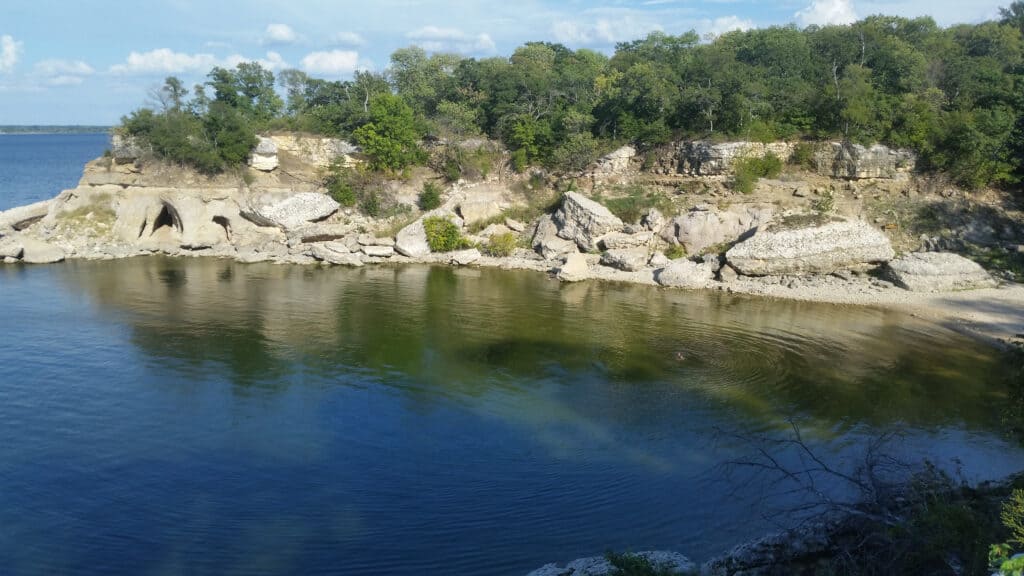
Lake Texoma is the largest reservoir in the U.S. Army Corps of Engineers (USACE) Tulsa District and the 12th largest lake in the USACE overall. Denison Dam on the Red River creates Lake Texoma. It is 720 miles up from the river’s mouth in Bryan County, Oklahoma, and Grayson County, Texas, where the Red River and the Washita River meet.
The dam was finished In 1944. Its site is 15 miles southwest of Durant, Oklahoma, and about 5 miles northwest of Denison, Texas. Lake Texoma is the USACE Tulsa District’s most popular and developed lake with about 6 million visitors annually. Oklahoma has a more significant piece of the lake than Texas does. The average depth is 39.9 feet, and the maximum depth is 100.
Where Is Lake Texoma on a Map?
Lake Texoma is located near the Texas and Oklahoma border and is only about an hour and a half drive north of Dallas. If you are coming North from Oklahoma City, the lake is roughly 180 miles south. On the other hand, it is close to 5 hours west of Little Rock, Arkansas.
What Type of Water is in Lake Texoma?

Lake Texoma is full of salt water, due to the salt that seeps from the Red River into it.
©Desmond Hebert/Shutterstock.com
The Red River, which flows into Lake Texoma, is a saltwater river. This is because salt deposits were left over from a sea that used to be in the area where Texas and Oklahoma meet 250 million years ago. Over time, that sea dried up, leaving behind salt deposits, mostly made of sodium chloride.
The salt deposits were eventually covered by rock and sand, but salt still leaks out through natural seeps in streams above Lake Texoma, sending as much as 3,450 tons of salt per day down the Red River. Many parts of the Red River’s water are too salty and must be treated in order for it to be drinkable. Striped bass, a saltwater fish, flourish in Lake Texoma as a result of this phenomenon. Lake Texoma is the only place in Texas where striped bass can live on their own.
Wildlife at Lake Texoma
Animals
There are two National Wildlife Refuges in the Lake Texoma area: Hagerman National Wildlife Refuge on the Texas side, and Tishomingo National Wildlife Refuge in Oklahoma. Both were established in 1946 to benefit migratory waterfowl and to provide a habitat for wildlife and plants native to the area.
What visitors see in these two refuges will largely depend on the season.
For example, winter is the time for geese, owls, hawks, fox squirrels, Northern harrier, red-shouldered hawks, and the bald eagle.
In spring and/or summer, the refuge will host monarch butterflies (who return in the fall), warblers, American white pelicans, hawks, hummingbirds, bluebirds, dickcissels, meadowlarks, painted buntings, Great blue heron, killdeer, white-tail deer, and blue- and green-winged teal.
In the fall, raptors and white pelicans make an appearance. Other birds that frequent the refuges include the winter wren, white-eyed vireo, LeConte’s sparrow, green-tailed towhee, vermilion flycatcher, and Say’s Phoebe. Sounds like a colorful bunch!
Plants and Fish
There are patches of floating heart and bushy pondweed, as well as water willow and American lotus. Blue-green algae blooms sometimes happen in this reservoir. Aside from that, there isn’t anything too exciting regarding plants.
In Texas and Oklahoma, millions of fishing licenses are sold each year. Old and young alike continue to enjoy it, and Lake Texoma is a popular place to go for recreational and competitive fishing. There are 28 kinds of fish that reside in Lake Texoma, according to the Texas Parks & Wildlife Department (TPWD). The most common fish here are:
- Bluegill
- Blue and channel catfish
- White & striped bass
- Largemouth and smallmouth bass
- Spotted bass
- Black and white crappie
The Most Exciting Part of Texoma!
The Compass Rose is a copy of a wooden Brigantine from the 1860s. It was built in 1968. It has a double hull made of mahogany and white oak ribs and is 60′ long. So that it can move around in shallow water and tight spots, it has a draft of only 6.5′. This shallow draft made ships like this one go faster than their enemies, which was great for getting around blockades.
When people sail on the Compass Rose, they get a once-in-a-lifetime chance to see what life was like on a Brigantine in the 1860s. The ship is like a floating museum full of old things from the time. You can help the crew run the ship under the direction of the Captain, or you can relax and enjoy the sail. Your visit will be treated with the utmost care, and the memories you make will last a lifetime.
The photo featured at the top of this post is © Desmond Hebert/Shutterstock.com
Sources
- Compass Rose, Available here: https://www.sailcompassrose.com/
- Wikipedia, Available here: https://en.wikipedia.org/wiki/Texoma
- Lake-Texoma.org, Available here: https://lake-texoma.org/
- Texoma Fishing, Available here: https://texoma-fishing.com/lake-texoma-fish-species/
Thank you for reading! Have some feedback for us? Contact the AZ Animals editorial team.






